Identifying Challenges and Solutions in Cultural Heritage Adaptive Reuse through the Historic Urban Landscape Approach in Amsterdam
Abstract
1. Introduction
2. Materials and Methods
2.1. Data Collection
2.2. Data Analysis
2.2.1. Definitions
2.2.2. Data Preparation and Content Analysis
2.2.3. Mapping
3. Results
3.1. Challenges, Solutions, and Statements
3.2. Factors
3.3. Tools
3.4. Stakeholders
4. Discussion and Conclusions
4.1. Factors
4.2. Tools
4.3. Stakeholders
4.4. Limitations and Outlook
4.5. Conclusive Remarks
Supplementary Materials
Author Contributions
Funding
Institutional Review Board Statement
Informed Consent Statement
Data Availability Statement
Acknowledgments
Conflicts of Interest
Appendix A
Appendix A.1. Data Collection
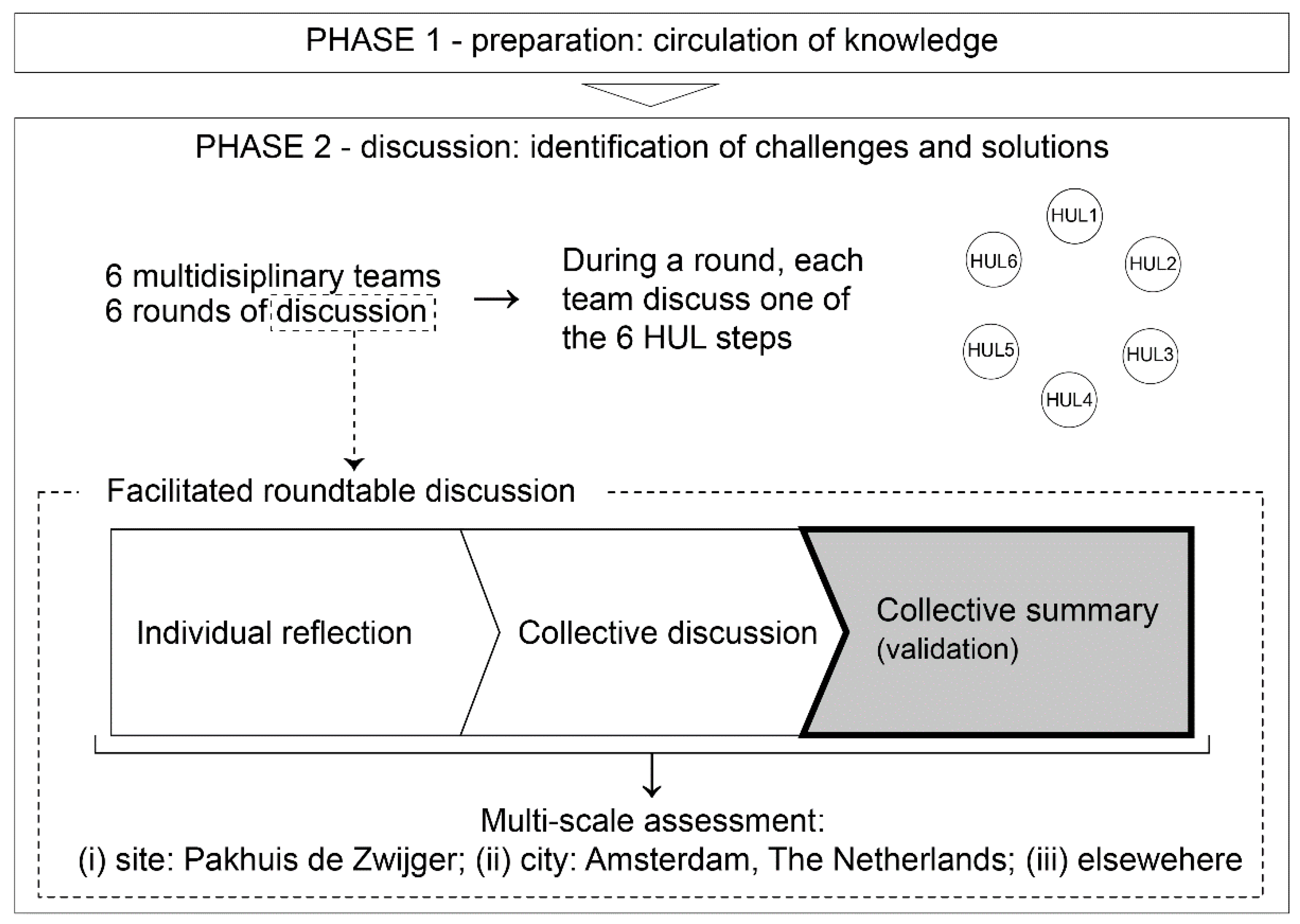
Appendix A.2. Data Analysis
Appendix A.2.1. Data Preparation and Cleaning
Appendix A.2.2. Coding
| Time of Coding | Coders | Type of Coding | Variable Coded | Number of Codes | Type of Analysis | Sample of Contributions Coded |
|---|---|---|---|---|---|---|
| Workshop | Workshop structure | Deductive | HUL step | 6 1 | Individual reflection, collective discussion, collective summary | |
| Participants | Deductive | Scale | 3 2 | Individual reflection, collective discussion, collective summary | ||
| Type of contribution | 2 3 | Individual reflection, collective discussion, collective summary | ||||
| Desk work | Authors (1 coder, 1 peer reviewer 4) | Deductive | Scale | 4 2 | Frequency [79] | Collective summary |
| Type of contribution | 3 5 | Frequency [79] | Collective summary | |||
| Inductive | Factor | 67 | Frequency and thematic synthesis [79]. Complexity mapping [107] | Collective summary indicated as challenges or solutions | ||
| Deductive | Tool | 4 6 | Existence [81] | Collective summary explicitly indicating a tool independently from the type of contribution | ||
| Stakeholder | 6 7 | Existence [81] | Collective summary explicitly indicating a stakeholder independently from the type of contribution |
Appendix B
| Themes | Number of Contributions |
|---|---|
| actor change | 4 |
| approach | 10 |
| awareness | 6 |
| benefit | 5 |
| business model | 1 |
| capacity | 5 |
| civic engagement | 24 |
| climate change | 2 |
| common good | 1 |
| communication | 8 |
| continuity | 4 |
| cooperation | 1 |
| cultural heritage | 7 |
| data | 13 |
| decision-making | 8 |
| democracy | 1 |
| demographic | 1 |
| diversification | 2 |
| economics | 4 |
| energy source | 1 |
| evidence | 1 |
| facilitation | 1 |
| financial pressure | 1 |
| flexibility | 3 |
| function | 4 |
| funding | 3 |
| gentrification | 2 |
| globalization | 1 |
| incentive | 2 |
| interdisciplinary | 4 |
| interest | 14 |
| knowledge | 28 |
| leadership | 3 |
| level | 3 |
| market pressure | 1 |
| mentality | 7 |
| negotiation | 8 |
| passports for reuse of buildings, elements, materials | 2 |
| physical state | 2 |
| planning | 1 |
| policy | 1 |
| PPPP | 2 |
| priority | 1 |
| opposition | 1 |
| real estate pressure | 2 |
| regulatory system | 6 |
| sense of belonging | 1 |
| sense of ownership | 1 |
| services | 2 |
| skills | 1 |
| sustainability | 1 |
| system change | 4 |
| tool | 7 |
| tourism | 5 |
| transparency | 7 |
| trust | 1 |
| unbalance rural-urban | 3 |
| urban fabric | 1 |
| valorization | 1 |
| value hierarchy | 2 |
| water management | 1 |
| actor change | 4 |
References
- United Nations Department of Economic and Social Affairs Population Division. World Urbanization Prospects. Available online: https://population.un.org/wup/Publications/Files/WUP2018-Report.pdf (accessed on 9 December 2019).
- United Nations (Habitat III) The New Urban Agenda. Available online: http://habitat3.org/wp-content/uploads/NUA-English.pdf (accessed on 9 December 2019).
- United Nations Human Settlements Programme (UN-Habitat) World Cities Report2016—Urbanization and Development: Emerging Futures. Available online: https://unhabitat.org/sites/default/files/download-manager-files/WCR-2016-WEB.pdf (accessed on 30 March 2021).
- Dessein, J.; Soini, K.; Fairclough, G.; Horlings, L. (Eds.) Culture in, for and as Sustainable Development: Conclusions from the COST Action IS1007 Investigating Cultural Sustainability; University of Jyväskylä: Jyväskylän, Finland, 2015; ISBN 9789513961770. [Google Scholar]
- Ellen MacArthur Foundation Completing the Picture: How the Circular Economy Tackles Climate Change. Available online: https://www.ellenmacarthurfoundation.org/assets/downloads/Completing_The_Picture_How_The_Circular_Economy-_Tackles_Climate_Change_V3_26_September.pdf (accessed on 9 December 2019).
- European Commission Communication from the Commission to the European Parliament, the Council, the European Economic and Social Committee and the Committee of the Regions. Closing the Loop—An EU Action Plan for the Circular Economy. COM(2015) 614 Final. Available online: https://eur-lex.europa.eu/legal-content/EN/TXT/?uri=CELEX%3A52015DC0614 (accessed on 3 November 2020).
- United Nations General Assembly Transforming Our World: The 2030 Agenda for Sustainable Development. Available online: https://sustainabledevelopment.un.org/content/documents/21252030AgendaforSustainableDevelopmentweb.pdf (accessed on 21 January 2020).
- CHCfE Consortium Cultural Heritage Counts for Europe. Available online: www.encatc.org/culturalheritagecountsforeurope (accessed on 5 September 2018).
- Winter, T. Climate change and our heritage of low carbon comfort. Int. J. Herit. Stud. 2016, 22, 382–394. [Google Scholar] [CrossRef]
- Burnham, B. Towards a New Heritage Financing Tool for Sustainable Development. In Proceedings of the Transdisciplinary Multispectral Modeling and Cooperation for the Preservation of Cultural Heritage, Athens, Greece, 10–13 October 2018; Moropoulou, A., Korres, M., Georgopoulos, A., Spyrakos, C., Mouzakis, C., Eds.; Springer: Cham, Switzerland, 2019; Volume 962, pp. 275–288. [Google Scholar] [CrossRef]
- Mora, L.; Bolici, R. How to Become a Smart City: Learning from Amsterdam. In Proceedings of the Smart and Sustainable Planning for Cities and Regions. SSPCR 2015, Bolzano, Italy, 19—20 November 2015; Bisello, A., Vettorato, D., Stephens, R., Elisei, P., Eds.; Green Energy and Technology. Springer: Cham, Switzerland, 2017; pp. 251–266, ISBN 978-3-319-44898-5. [Google Scholar] [CrossRef]
- Guzmán, P.C.; Pereira Roders, A.R.; Colenbrander, B.J.F. Measuring links between cultural heritage management and sustainable urban development: An overview of global monitoring tools. Cities 2017, 60, 192–201. [Google Scholar] [CrossRef]
- Ost, C. Revisiting Heritage Conservation in its Social and Economic Background. In Proceedings of the LDE Heritage Conference on Heritage and the Sustainable Development Goals, Delft, The Netherlands, 26–28 November 2019; Pottgiesser, U., Fatorić, S., Hein, C., de Maaker, E., Pereira Roders, A., Eds.; TU Delft Open: Delft, The Netheralnds, 2021; pp. 280–289. [Google Scholar]
- Tweed, C.; Sutherland, M. Built cultural heritage and sustainable urban development. Landsc. Urban Plan. 2007, 83, 62–69. [Google Scholar] [CrossRef]
- Labadi, S.; Giliberto, F.; Rosetti, I.; Shetabi, L.; Yildirim, E. Heritage and the Sustainable Development Goals: Policy Guidance for Heritage and Development Actors. Available online: https://www.icomos.org/images/DOCUMENTS/Secretariat/2021/SDG/ICOMOS_SDGs_Policy_Guidance_2021.pdf (accessed on 10 May 2021).
- ICOMOS International Charter for the Conservation and Restoration of Monuments and Sites (The Venice Charter 1964). Available online: https://www.icomos.org/charters/venice_e.pdf (accessed on 3 November 2020).
- Heath, T. Adaptive re-use of offices for residential use: The experiences of London and Toronto. Cities 2001, 18, 173–184. [Google Scholar] [CrossRef]
- Galdini, R. Urban re-use practices in contemporary cities: Experiences in Europe. Cities 2019, 87, 103–105. [Google Scholar] [CrossRef]
- Fusco Girard, L. The circular economy in transforming a died heritage site into a living ecosystem, to be managed as a complex adaptive organism. Aestimum 2020. [Google Scholar] [CrossRef]
- Conejos, S.; Langston, C.; Chan, E.H.W.W.; Chew, M.Y.L.L. Governance of heritage buildings: Australian regulatory barriers to adaptive reuse. Build. Res. Inf. 2016, 3218, 507–519. [Google Scholar] [CrossRef]
- Martani, C. The risks of decisions with long-term impacts within the building process. The uncertainty in design over a set of objectives for the operation and maintenance phase. In Risk Management in Architectural Design. Control of Uncertainty over Building Use and Maintenance; Springer: Cham, Switzerland, 2015; pp. 3–12. ISBN 978-3-319-07449-8. [Google Scholar] [CrossRef]
- Geraedts, R.P.; Wamelink, J.W. Het bouwproces. In Inleiding Bouwmanagement; Wamelink, J.W.F., Ed.; VVSD: Delft, The Netheralnds, 2009; pp. 1–34. [Google Scholar]
- Wilkinson, S.J. Defining Adaptation. In Sustainable Building Adaptation: Innovations in Decision-Making; Wilkinson, S.J., Remøy, H., Langston, C., Eds.; Wiley Blackwell: Oxford, UK, 2014; pp. 3–17. ISBN 9781118477106. [Google Scholar] [CrossRef]
- Plevoets, B.; Van Cleempoel, K. Adaptive Reuse of the Built Heritage; Routledge: London, UK, 2019. [Google Scholar] [CrossRef]
- Foster, G. Circular economy strategies for adaptive reuse of cultural heritage buildings to reduce environmental impacts. Resour. Conserv. Recycl. 2020, 152, 104507. [Google Scholar] [CrossRef]
- Yung, E.H.K.; Chan, E.H.W. Implementation challenges to the adaptive reuse of heritage buildings: Towards the goals of sustainable, low carbon cities. Habitat Int. 2012, 36, 352–361. [Google Scholar] [CrossRef]
- Bullen, P.A.; Love, P.E.D. Adaptive reuse of heritage buildings. Struct. Surv. 2011, 29, 411–421. [Google Scholar] [CrossRef]
- Fusco Girard, L. Implementing the circular economy: The role of cultural heritage as the entry point.Which evaluation approaches? BDC Bollettion del Cent. Calza Bini 2019, 9, 245–277. [Google Scholar] [CrossRef]
- Hill, S. Constructive conservation—A model for developing heritage assets. J. Cult. Herit. Manag. Sustain. Dev. 2016, 6, 34–46. [Google Scholar] [CrossRef]
- Gustafsson, C. Conservation 3.0—Cultural heritage as a driver for regional growth. SCIRES it 2019, 9, 21–32. [Google Scholar] [CrossRef]
- Sesana, E.; Gagnon, A.; Bertolin, C.; Hughes, J. Adapting Cultural Heritage to Climate Change Risks: Perspectives of Cultural Heritage Experts in Europe. Geosciences 2018, 8, 305. [Google Scholar] [CrossRef]
- Fatorić, S.; Egberts, L. Realising the potential of cultural heritage to achieve climate change actions in the Netherlands. J. Environ. Manag. 2020, 274, 111107. [Google Scholar] [CrossRef] [PubMed]
- Fusco Girard, L.; Vecco, M. The “Intrinsic Value” of Cultural Heritage as Driver for Circular Human-Centered Adaptive Reuse. Sustainability 2021, 13, 3231. [Google Scholar] [CrossRef]
- Gravagnuolo, A.; Angrisano, M.; Girard, L.F. Circular economy strategies in eight historic port cities: Criteria and indicators towards a circular city assessment framework. Sustainability 2019, 11, 3512. [Google Scholar] [CrossRef]
- About CLIC Project. Available online: https://www.clicproject.eu/about/ (accessed on 15 April 2021).
- CLIC Consortium CLIC Project. Available online: https://www.clicproject.eu/ (accessed on 9 December 2019).
- Pintossi, N.; Ikiz Kaya, D.; Pereira Roders, A. Adaptive Reuse of Cultural Heritage in Amsterdam: Identifying challenges and solutions through the Historic Urban Landscape approach. In Proceedings of the LDE Heritage Conference on Heritage and the Sustainable Development Goals, Delft, The Netherlands, 26–28 November 2019; Pottgiesser, U., Fatorić, S., Hein, C., de Maaker, E., Pereira Roders, A., Eds.; TU Delft Open: Delft, The Netherlands, 2021; pp. 304–314. [Google Scholar]
- Pottgiesser, U.; Fatoric, S.; Hein, C.; de Maaker, E.; Pereira Roders, A. (Eds.) LDE heritage conference on Heritage and the Sustainable Development Goals: Proceedings; TU Delft Open: Delft, The Netherlands, 2021; ISBN 978-94-6366-356-4. [Google Scholar]
- Douglas, J. Building Adaptation, 2nd ed.; Butterworth-Heinemann: Oxford, UK, 2006; ISBN 9780750666671. [Google Scholar]
- Bullen, P.A. Adaptive reuse and sustainability of commercial buildings. Facilities 2007, 25, 20–31. [Google Scholar] [CrossRef]
- Remøy, H.; Van Der Voordt, T. Adaptive reuse of office buildings into housing: Opportunities and risks. Build. Res. Inf. 2014, 42, 381–390. [Google Scholar] [CrossRef]
- Wilkinson, S.J. Drivers and Barriers for Adaptation. In Sustainable Building Adaptation: Innovations in Decision-making; Wilkinson, S.J., Remøy, H., Langston, C., Eds.; Wiley-Blackwell: Oxford, UK, 2014; pp. 18–41. [Google Scholar]
- Australia ICOMOS The Burra Charter: The Australia ICOMOS Charter for Places of Cultural Significance. Available online: http://australia.icomos.org/ (accessed on 4 September 2020).
- Elrod, J.K.; Fortenberry, J.L. Adaptive reuse in the healthcare industry: Repurposing abandoned buildings to serve medical missions. BMC Health Serv. Res. 2017, 17, 5–14. [Google Scholar] [CrossRef] [PubMed]
- Giuliani, F.; De Falco, A.; Landi, S.; Bevilacqua, M.G.; Santini, L.; Pecori, S.; De Falco, A.; Landi, S.; Giorgio Bevilacqua, M.; Santini, L.; et al. Reusing grain silos from the 1930s in Italy. A multi-criteria decision analysis for the case of Arezzo. J. Cult. Herit. 2018, 29, 145–159. [Google Scholar] [CrossRef]
- Hettema, J.; Egberts, L. Designing with maritime heritage: Adaptive re-use of small-scale shipyards in northwest Europe. J. Cult. Herit. Manag. Sustain. Dev. 2019, 10, 130–143. [Google Scholar] [CrossRef]
- Bullen, P.A.; Love, P.E.D. A new future for the past: A model for adaptive reuse decision-making. Built Environ. Proj. Asset Manag. 2011, 1, 32–44. [Google Scholar] [CrossRef]
- Mısırlısoy, D.; Günce, K. Adaptive reuse strategies for heritage buildings: A holistic approach. Sustain. Cities Soc. 2016, 26, 91–98. [Google Scholar] [CrossRef]
- Veldpaus, L.; Pereira Roders, A.R.; Colenbrander, B.J.F. Urban Heritage: Putting the Past into the Future. Hist. Environ. Policy Pract. 2013, 4, 3–18. [Google Scholar] [CrossRef]
- Council of Europe Council of Europe Framework Convention on the Value of Cultural Heritage for Society. Available online: https://rm.coe.int/1680083746 (accessed on 21 January 2021).
- UNESCO Recommendation on the Historic Urban Landscape. Available online: https://whc.unesco.org/document/172639 (accessed on 26 June 2018).
- Lami, I.M. Shapes, Rules and Value. In Abandoned Buildings in Contemporary Cities: Smart Conditions for Actions; Lami, I.M., Ed.; Springer: Cham, Switzerland, 2020; pp. 149–162. [Google Scholar] [CrossRef]
- Bergold, J.; Stefan, T. Participatory Research Methods: A Methodological Approach in Motion. Forum Qual. Sozialforsch./Forum Qual. Soc. Res. 2012, 13. [Google Scholar] [CrossRef]
- Brown, J.; Isaacs, D.; The World Café Community. The World Café: Shaping our Future through Conversations that Matter; Berrett-Koehler Publisher: San Francisco, CA, USA, 2005. [Google Scholar]
- Brouwer, H.; Brouwers, J. The MSP Tool Guide: Sixty tools to facilitate multi-stakeholder partnerships. Companion to The MSP Guide; Wageningen University and Research, CDI: Wageningen, The Netheralnds, 2017. [Google Scholar]
- Löhr, K.; Weinhardt, M.; Sieber, S. The “World Café” as a Participatory Method for Collecting Qualitative Data. Int. J. Qual. Methods 2020, 19, 1–15. [Google Scholar] [CrossRef]
- Broom, M.; Brady, B.; Kecskes, Z.; Kildea, S. World café methodology engages stakeholders in designing a neonatal intensive care unit. J. Neonatal Nurs. 2013, 19, 253–258. [Google Scholar] [CrossRef]
- Kavanagh, O.N.; Moriarty, F.; Bradley, C.; O’Hagan, J.; Stack, G.; Kelly, D. More than coffee—A World Café to explore enablers of pharmacy practice research. Int. J. Pharm. Pract. 2020, 28, 512–521. [Google Scholar] [CrossRef]
- Palacios-Agundez, I.; Casado-Arzuaga, I.; Madariaga, I.; Onaindia, M. The relevance of local participatory scenario planning for ecosystem management policies in the Basque Country, northern Spain. Ecol. Soc. 2013, 18. [Google Scholar] [CrossRef]
- Silva, S.; Guenther, E. Setting the research agenda for measuring sustainability performance—Systematic application of the world café method. Sustain. Accounting, Manag. Policy J. 2018, 9, 455–469. [Google Scholar] [CrossRef]
- UNESCO Proposals Concerning the Desirability of a Standard-Setting Instrument on Historic Urban Landscapes. 36 C/23 REV. Available online: https://unesdoc.unesco.org/ark:/48223/pf0000211094 (accessed on 31 January 2020).
- Van Oers, R. Swahili Historic Urban Landscapes: Report on the Historic Urban Landscape Workshops and Field Activities on the Swahili coast in East Africa 2011-2012; UNESCO: Paris, France, 2013. [Google Scholar]
- Pintossi, N.; Ikiz Kaya, D.; Pereira Roders, A. Assessing Cultural Heritage Adaptive Reuse Practices: Multi-Scale Challenges and Solutions in Rijeka. Sustainability 2021, 13, 3603. [Google Scholar] [CrossRef]
- Ginzarly, M.; Houbart, C.; Teller, J. The Historic Urban Landscape approach to urban management: A systematic review. Int. J. Herit. Stud. 2019, 25, 999–1019. [Google Scholar] [CrossRef]
- Rodwell, D. Sustainability and the Holistic Approach to the Conservation of Historic Cities. J. Archit. Conserv. 2003, 9, 58–73. [Google Scholar] [CrossRef]
- Wilkinson, S.J. The Context for Building Resilience through Sustainable Change of Use Adaptation. In Building Urban Resilience through Change of Use; Wilkinson, S.J., Remøy, H., Eds.; Wiley Blackwell: Oxford, UK, 2018; pp. 1–20. [Google Scholar] [CrossRef]
- Architectenbureau, J.; van Stigt, B.V. Pakhuis de Zwijger. Available online: https://burovanstigt.nl/en/product/pakhuis-de-zwijger-2/ (accessed on 23 January 2020).
- Pakhuis de Zwijger About Us. Available online: https://dezwijger.nl/over-ons/about-us/ (accessed on 23 January 2020).
- Stadsherstel Amsterdam n.v. Stadsherstel Amsterdam: The Company for City Restoration. Available online: https://www.stadsherstel.nl/ul/cms/fck-uploaded/StadsherstelEngels2011.pdf (accessed on 13 February 2020).
- Renovatie Pakhuis De Zwijger Amsterdam. Architecten Bureau J. van Stigt, Amsterdam [Amsterdam Pakuis De Zwijger Renovation. Arctitects Studio J. van Stigt, Amsterdam]. Available online: https://burovanstigt.nl/wp-content/uploads/2018/10/Pakhuis-de-Zwijger-Renovatie-Pakhuis-de-Zwijger-Amsterdam.pdf (accessed on 11 May 2021).
- van Stigt, A.J. Pakhuis de Zwijger/De Zwijger Warehouse. Available online: https://www.burovanstigt.nl/wp-content/uploads/2018/10/PakhuisdeZwijger-A.J.vanstigtvertelt.pdf (accessed on 10 May 2021).
- Herbestemming.nu Pakhuis de Zwijger, Amsterdam. Available online: https://www.herbestemming.nu/projecten/pakhuis-de-zwijger-amsterdam (accessed on 10 May 2021).
- Ikiz Kaya, D.; Lu, L.; Pintossi, N.; Pereira Roders, A. Operationalising the HUL tools at Building Level: Circular Models of Adaptive Reuse. In Proceedings of the LDE Heritage Conference on Heritage and the Sustainable Development Goals, Delft, The Netherlands, 26–28 November 2019; BK Open: Delft, The Netherlands, 2021. [Google Scholar]
- City of Amsterdam Policy: Listed Monuments. Available online: https://www.amsterdam.nl/en/policy/policy-culture-arts/listed-monuments/ (accessed on 10 December 2019).
- Veldpaus, L.; Bokhove, H. Integrating Policy: The Historic Urban Landscape Approach in Amsterdam. In Reshaping Urban Conservation: The Historic Urban Landscape Approach in Action; Pereira Roders, A., Bandarin, F., Eds.; Springer: Singapore, 2019; ISBN 978-981-10-8886-5. [Google Scholar] [CrossRef]
- Circle Economy; Fabric; TNO Circular Amsterdam: A Vision and Action Agenda for the City and Metropolitan Area. Available online: https://circle-economy.com/amsterdamcirclecityscan (accessed on 24 October 2018).
- Prendeville, S.; Cherim, E.; Bocken, N. Circular Cities: Mapping Six Cities in Transition. Environ. Innov. Soc. Transitions 2018, 26, 171–194. [Google Scholar] [CrossRef]
- Eisenack, K.; Moser, S.C.; Hoffmann, E.; Klein, R.J.T.; Oberlack, C.; Pechan, A.; Rotter, M.; Termeer, C.J.A.M. Explaining and overcoming barriers to climate change adaptation. Nat. Clim. Chang. 2014, 4, 867–872. [Google Scholar] [CrossRef]
- Thomas, J.; Harden, A. Methods for the thematic synthesis of qualitative research in systematic reviews. BMC Med. Res. Methodol. 2008, 8, 45. [Google Scholar] [CrossRef]
- Wickham, H. Tidy data. J. Stat. Softw. 2014, 59, 1–23. [Google Scholar] [CrossRef]
- Krippendorff, K. Content Analysis: An Introduction to Its Methodology; Sage: London, UK, 1980. [Google Scholar]
- Bengtsson, M. How to plan and perform a qualitative study using content analysis. NursingPlus Open 2016, 2, 8–14. [Google Scholar] [CrossRef]
- Calzada, I. Critical social innovation in the smart city era for a city-regional European Horizon 2020. P3T J. Public Policies Territ. Soc. Innov. Territ. 2013, 6, 1–20. [Google Scholar]
- Pentahelix Project Pentahelix Project—Deliverable 2.1 Baseline Report. Available online: https://pentahelix.eu/wp-content/uploads/2019/04/Baseline-report.pdf (accessed on 13 February 2020).
- Shannon, P.; Markiel, A.; Ozier, O.; Baliga, N.S.; Wang, J.T.; Ramage, D.; Amin, N.; Schwikowski, B.; Ideker, T. Cytoscape: A Software Environment for Integrated Models of Biomolecular Interaction Networks. Genome Res. 2003, 13, 2498–2504. [Google Scholar] [CrossRef]
- Spectral Jouliette at De Ceuvel. Available online: https://spectral.energy/news-3/jouliette-at-deceuvel/ (accessed on 13 February 2020).
- Bullen, P.A.; Love, P.E.D. Factors influencing the adaptive re-use of buildings. J. Eng. Des. Technol. 2011, 9, 32–46. [Google Scholar] [CrossRef]
- Vecco, M. A definition of cultural heritage: From the tangible to the intangible. J. Cult. Herit. 2010, 11, 321–324. [Google Scholar] [CrossRef]
- Landorf, C. A Framework for Sustainable Heritage Management: A Study of UK Industrial Heritage Sites. Int. J. Herit. Stud. 2009, 15, 494–510. [Google Scholar] [CrossRef]
- Bandarin, F. Reshaping Urban Conservation. In Reshaping Urban Conservation. The Historic Urban Landscape Approach in Action; Pereira Roders, A., Bandarin, F., Eds.; Springer: Singapore, 2019; pp. 3–20. [Google Scholar] [CrossRef]
- Architects’ Council of Europe Leeuwarden Declaration: Adaptive Re-Use of the Built Heritage: Preserving and Enhancing the Values of Our Built Heritage for Future Generations. Available online: https://www.ace-cae.eu/uploads/tx_jidocumentsview/LEEUWARDEN_STATEMENT_FINAL_EN-NEW.pdf (accessed on 13 February 2020).
- Davos Declaration 2018. Available online: https://davosdeclaration2018.ch/media/Brochure_Declaration-de-Davos-2018_WEB_2.pdf (accessed on 13 February 2020).
- UNESCO The Hangzhou Declaration: Placing Culture at the Heart of Sustainable Development Policies. Available online: http://www.unesco.org/new/fileadmin/MULTIMEDIA/HQ/CLT/images/FinalHangzhouDeclaration20130517.pdf (accessed on 21 January 2021).
- Spanish EU Presidency Toledo Informal Ministerial Meeting on Urban Development: Declaration. Available online: http://urban-intergroup.eu/wp-content/files_mf/es2010itoledodeclaration.pdf (accessed on 21 February 2020).
- Li, J.; Krishnamurthy, S.; Pereira Roders, A.; van Wesemael, P. Community participation in cultural heritage management: A systematic literature review comparing Chinese and international practices. Cities 2020, 96. [Google Scholar] [CrossRef]
- Tourism & Transport Forum Australia Built Heritage and the Visitor Economy: The Case for Adaptive Re-Use of Heritage Assets. Available online: https://www.ttf.org.au/wp-content/uploads/2017/02/TTF-Adaptive-re-use-of-built-heritage-report.pdf (accessed on 21 February 2020).
- Municipality of Amsterdam. City in Balance 2018-2022: Towards a new equilibrium between quality of life and hospitality; Municipality of Amsterdam: Amstedam, The Netherlands, 2019.
- Gerritsma, R. Overcrowded Amsterdam: Striving for a balance between trade, tolerance and tourism. In Overtourism: Excesses, Discontents and Measures in Travel and Tourism; Milano, C., Cheer, J.M., Novelli, M., Eds.; CAB International: Wallingford, UK, 2019; pp. 125–147. [Google Scholar] [CrossRef]
- Koens, K.; Postma, A.; Papp, B. Is Overtourism Overused? Understanding the Impact of Tourism in a City Context. Sustainability 2018, 10, 4384. [Google Scholar] [CrossRef]
- Butler, R.W. Seasonality in Tourism: Issues and Implications. In Seasonality in Tourism; Baum, T., Lundtorp, S., Eds.; Routledge: Oxford, UK, 2001; pp. 13–30. ISBN 9780080516806. [Google Scholar] [CrossRef]
- Court, S.; Wijesuriya, G. People-Centred Approaches to the Conservation of Cultural Heritage: Living Heritage; ICCROM: Rome, Italy, 2015. [Google Scholar]
- Dyson, K.; Matthews, J.; Love, P.E.D. Critical success factors of adapting heritage buildings: An exploratory study. Built Environ. Proj. Asset Manag. 2016, 6, 44–57. [Google Scholar] [CrossRef]
- Shipley, R.; Utz, S.; Parsons, M. Does adaptive reuse pay? A study of the business of building renovation in Ontario, Canada. Int. J. Herit. Stud. 2006, 12, 505–520. [Google Scholar] [CrossRef]
- Bourne, L.S. Reurbanization, Uneven Urban Development, and the Debate on New Urban Forms. Urban Geogr. 1996, 17, 690–713. [Google Scholar] [CrossRef]
- Janesick, V.J. Peer Debriefing. In The Blackwell Encyclopedia of Sociology; John Wiley & Sons, Ltd.: Oxford, UK, 2015. [Google Scholar] [CrossRef]
- World Heritage Centre—Recommendation on the Historic Urban Landscape. Available online: https://whc.unesco.org/en/hul/ (accessed on 13 February 2020).
- Dynamical Systems Innovation Lab. Complexity Mapping in Practice and Research: Methods, Trends, and Future Directions; Dynamical Systems Innovation Lab: Honolulu, HI, USA, 2014. [Google Scholar]
- Bolognesi, M.; Pilgram, R.; van den Heerik, R. Reliability in content analysis: The case of semantic feature norms classification. Behav. Res. Methods 2017, 49, 1984–2001. [Google Scholar] [CrossRef]
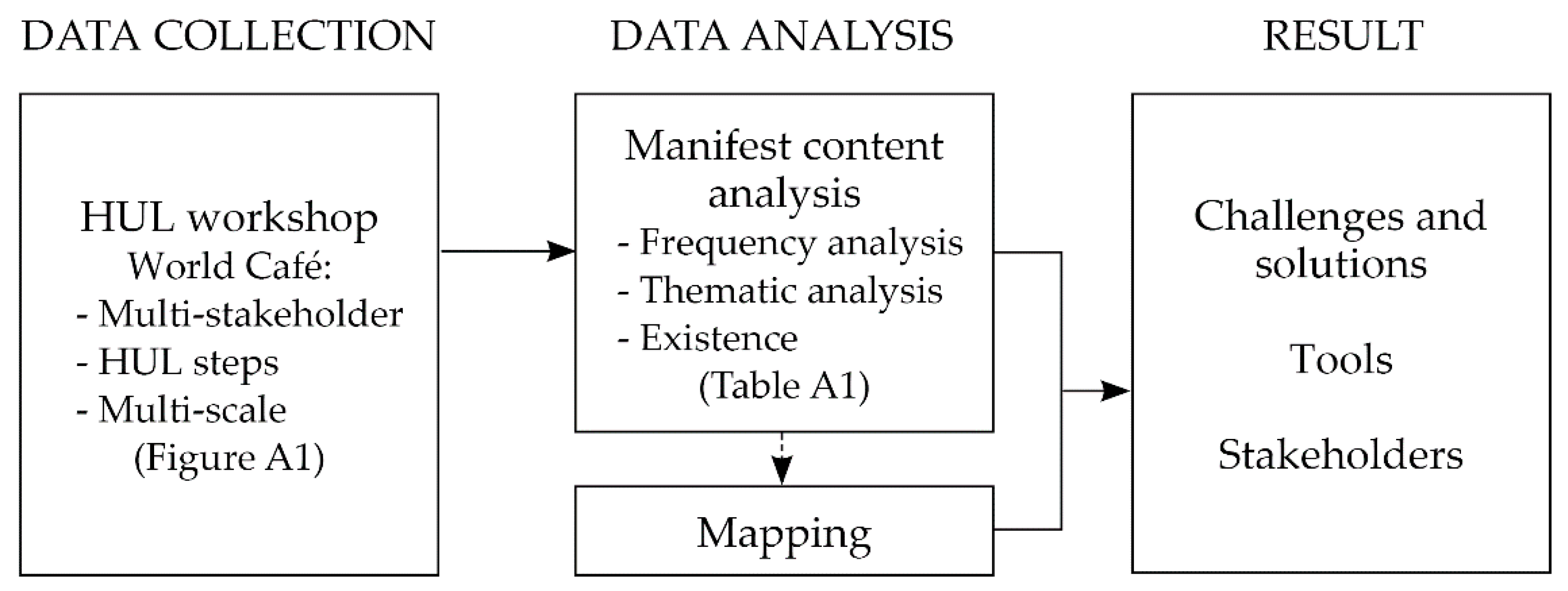

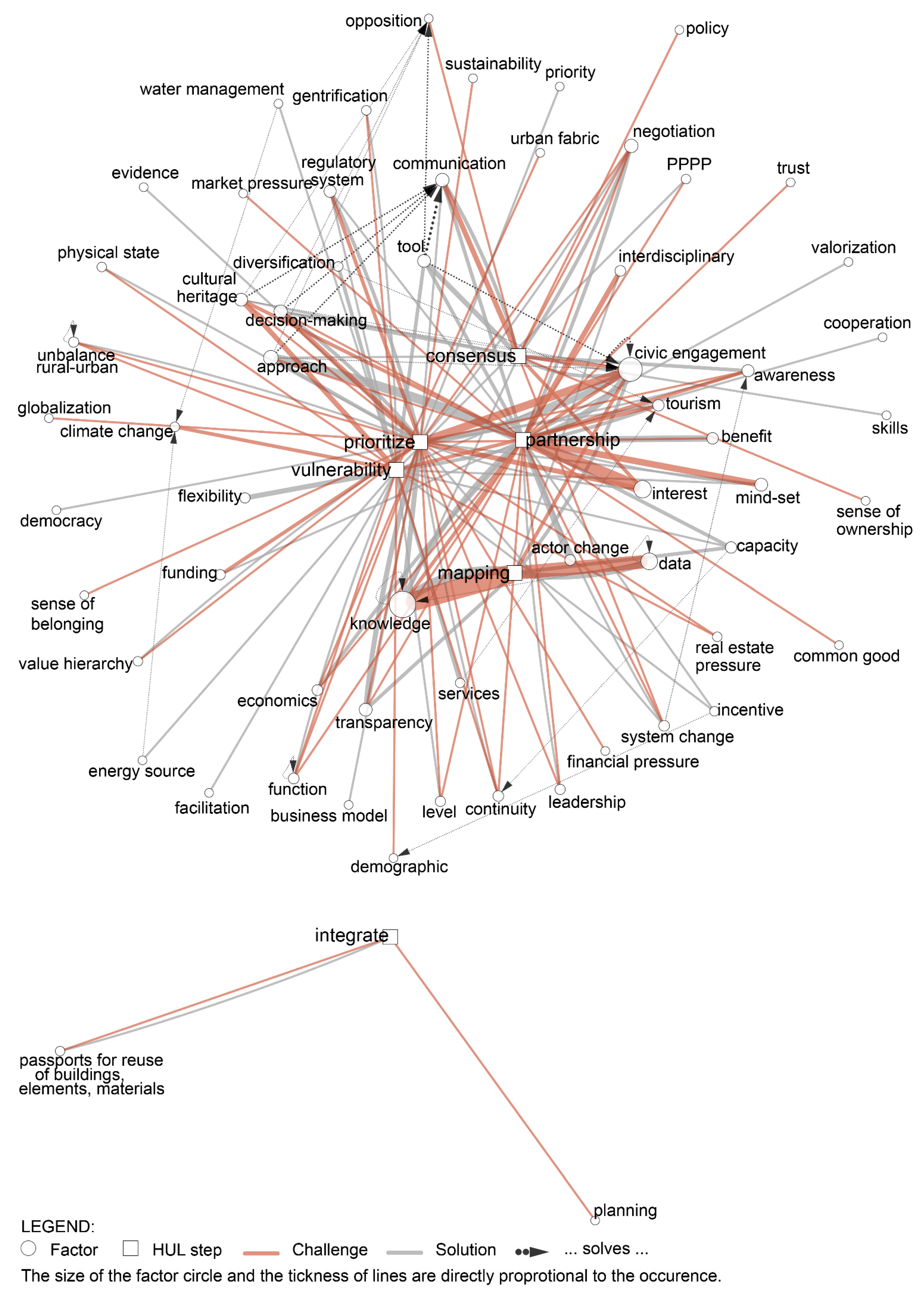
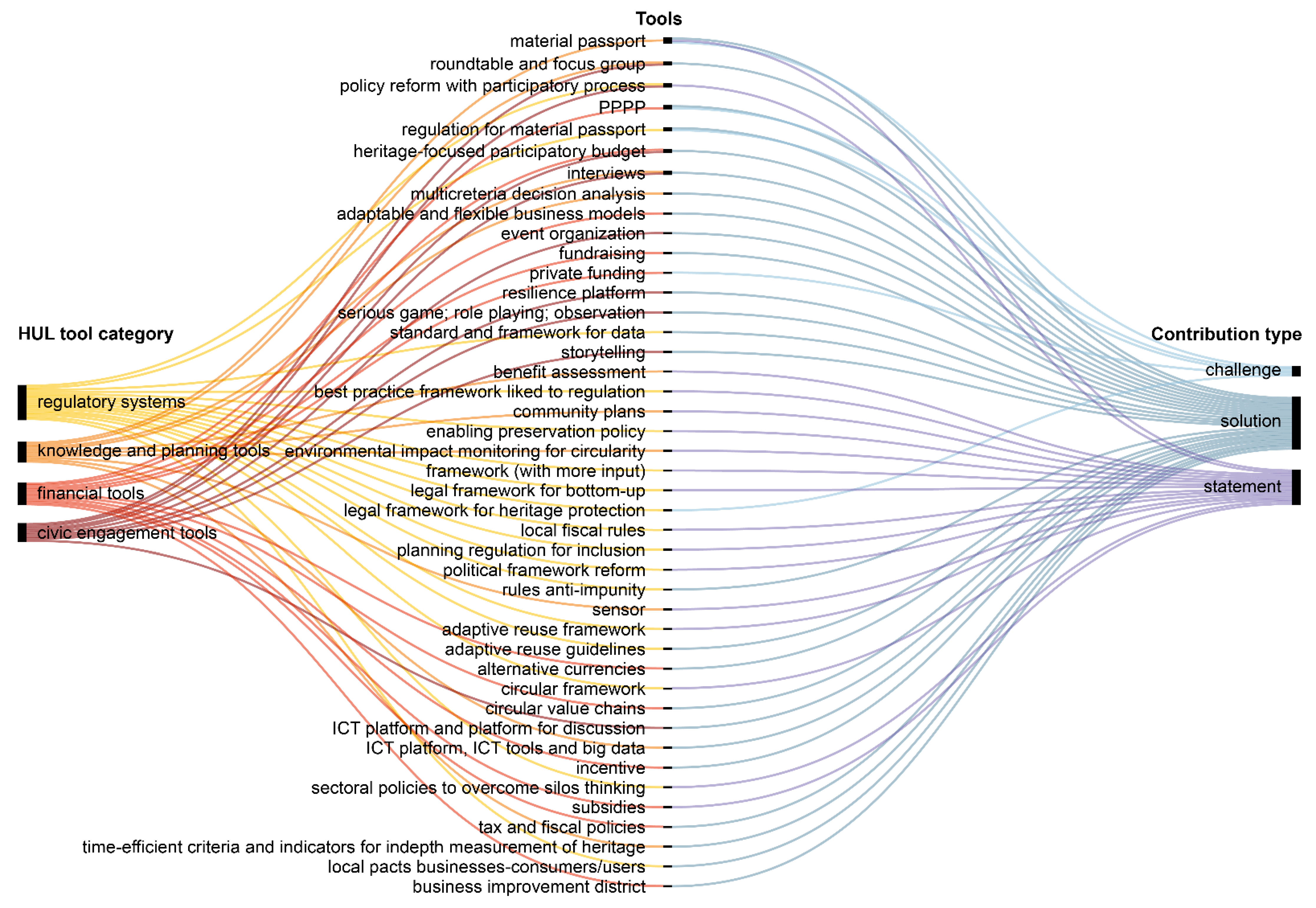
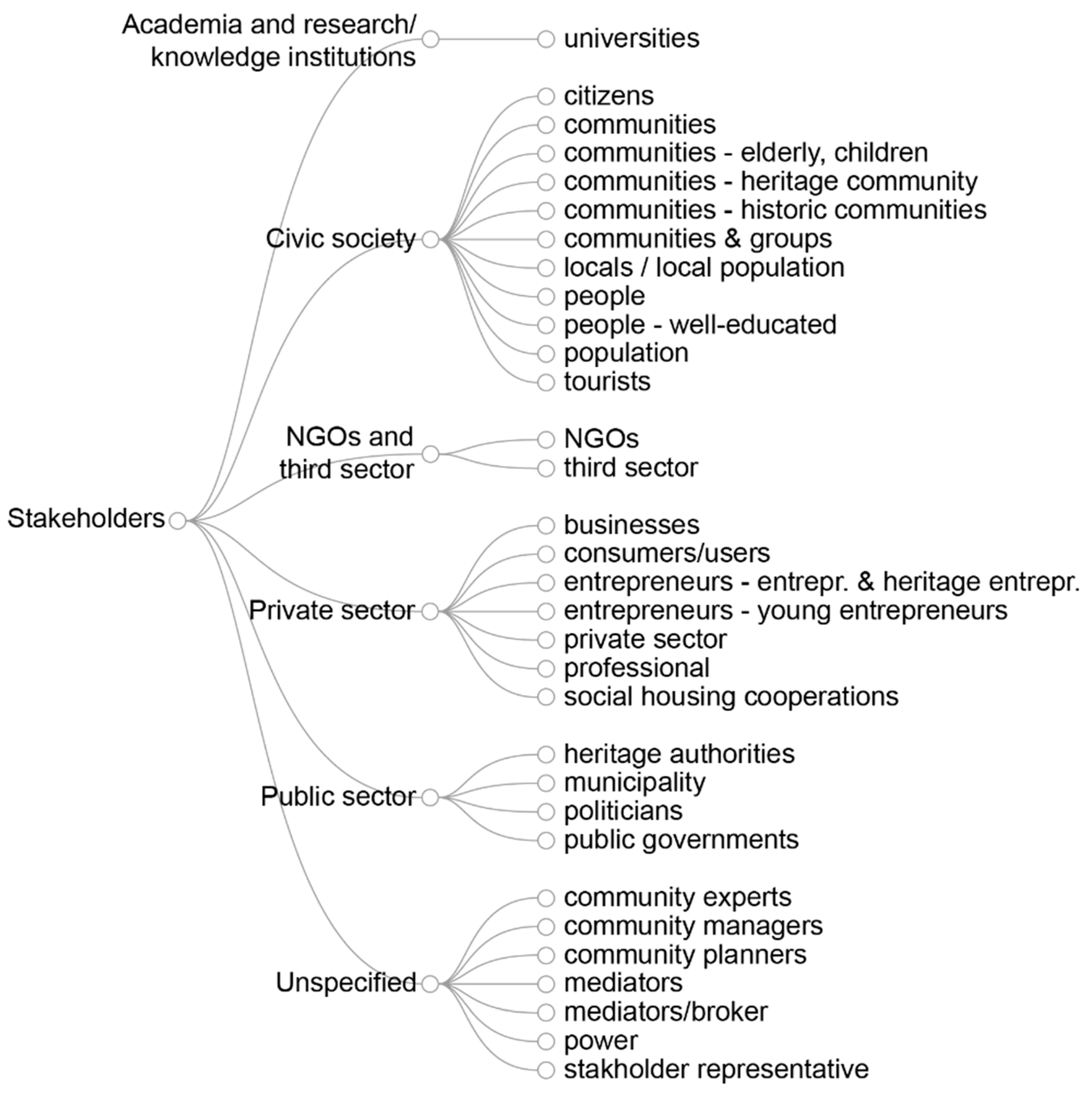
| Short Name | HUL Step Description 1 |
|---|---|
| Mapping | Mapping natural, cultural, and human resource |
| Consensus | Reaching consensus on what values and related attributes to protect |
| Vulnerability | Assessing the vulnerability of the identified values and related attributes to change and development |
| Integrate | Integrating values, related attributes, and their vulnerability in the urban development framework |
| Prioritize or Prioritization | Prioritizing actions for conservation and development |
| Partnership | Establishing local partnerships and management frameworks for each of the actions |
| Key Concept | Definition | Reference |
|---|---|---|
| Factor | Identified element that affects the adaptive reuse of cultural heritage. Depending on the context, it entails a challenge or a solution. Used to collectively refer to challenges and solutions. | [37] |
| Challenge | Any factor negatively affecting the adaptive reuse of cultural heritage. It encompasses challenges, barriers, constraints, obstacles, or hurdles hampering the adaptive reuse of cultural heritage. | [78] |
| Solution | Any factor positively affecting the adaptive reuse of cultural heritage by overcoming a challenge. | - |
| Statement | Contribution identified neither as a challenge nor as a solution. | - |
| Theme | Topic shared among contributions identified by content analysis. | [79] |
| Theme | Number of Contributions | Definition | Example of Factor - for Challenges, + for Solutions | |
|---|---|---|---|---|
| Knowledge | 28 | Understanding of and information about cultural heritage and adaptive reuse, and their context | - | Lack of knowledge |
| + | Knowledge acquisition | |||
| Civic Engagement | 24 | Adoption and implementation of participation processes of all sorts of stakeholders | - | Lack of time and resources for participation |
| + | Use of ICT platforms to involve citizens | |||
| Interest | 14 | Concern for the process of adaptive reuse resulting from the willingness of participation or benefits/advantages foreseen or derived from this process | - | Conflicting interest among actors |
| + | Ensuring equity of roles among stakeholders | |||
| Data | 13 | Element collected to be used to inform a decision or a reasoning | - | Data lacking structure, comparability, and interoperability |
| + | Interoperable and user-friendly platforms of open data | |||
| Decision- Making | 8 | Process of making decisions | - | Top-down decision-making |
| + | Balancing top-down and bottom-up decision-making | |||
| Approach | 10 | Ways adopted to deal with and carry out the adaptive reuse of cultural heritage | - | Competition within a sector |
| + | A future-oriented approach emphasizing the common future instead of the common past | |||
| Negotiation | 8 | Processes aiming at reaching some sort of consensus among parties | - | Lack of mediation |
| + | External mediator/broker | |||
| Communication | 8 | Exchange of information among actors | - | Jargon, e.g., understanding “cultural heritage” |
| + | Definitions and lay language | |||
| Cultural Heritage | 7 | Recognition or management of cultural heritage | - | Heritage not being a priority |
| + | Providing evidence of the usefulness of cultural heritage | |||
| Mindset | 7 | Demands for a shift in mindset | - | Risk-adverse mentality, fearing the unknown |
| + | Promoting flexibility by changing mentality through the third sector | |||
| Transparency | 7 | Clarity and access to information | - | The mismatch between the expectation andthe outcome |
| + | Enhancing transparency of processes anddecision-making | |||
| Tools | 7 | Mention of a tool | + | Business improvement districts for partnerships |
| Awareness | 6 | Realization of a fact and concern about a situation | - | Lack of awareness within the community |
| + | ICT playing games to raise awareness | |||
| Regulatory System | 6 | Policy, frameworks, legislation, and regulations | - | “Manipulation of the legal framework for the protection of heritage” |
| + | Regulation to allow experimentation in solutions/processes | |||
| Benefit | 5 | Foreseeing and proving benefits derivable from the adaptive reuse of cultural heritage | - | Lack of ability to foresee distribution of impacts |
| + | Providing evidence of the potential benefits | |||
| Capacity | 5 | Capacity-building | + | Building capacity to create “heritage brokers” |
| Tourism | 5 | The system related to people visiting places | - | Reuse of cultural heritage as a touristic attraction provokes a loss of uses intended for locals |
| + | Conceiving of solutions working all year long and for both tourists and locals |
Publisher’s Note: MDPI stays neutral with regard to jurisdictional claims in published maps and institutional affiliations. |
© 2021 by the authors. Licensee MDPI, Basel, Switzerland. This article is an open access article distributed under the terms and conditions of the Creative Commons Attribution (CC BY) license (https://creativecommons.org/licenses/by/4.0/).
Share and Cite
Pintossi, N.; Ikiz Kaya, D.; Pereira Roders, A. Identifying Challenges and Solutions in Cultural Heritage Adaptive Reuse through the Historic Urban Landscape Approach in Amsterdam. Sustainability 2021, 13, 5547. https://doi.org/10.3390/su13105547
Pintossi N, Ikiz Kaya D, Pereira Roders A. Identifying Challenges and Solutions in Cultural Heritage Adaptive Reuse through the Historic Urban Landscape Approach in Amsterdam. Sustainability. 2021; 13(10):5547. https://doi.org/10.3390/su13105547
Chicago/Turabian StylePintossi, Nadia, Deniz Ikiz Kaya, and Ana Pereira Roders. 2021. "Identifying Challenges and Solutions in Cultural Heritage Adaptive Reuse through the Historic Urban Landscape Approach in Amsterdam" Sustainability 13, no. 10: 5547. https://doi.org/10.3390/su13105547
APA StylePintossi, N., Ikiz Kaya, D., & Pereira Roders, A. (2021). Identifying Challenges and Solutions in Cultural Heritage Adaptive Reuse through the Historic Urban Landscape Approach in Amsterdam. Sustainability, 13(10), 5547. https://doi.org/10.3390/su13105547






